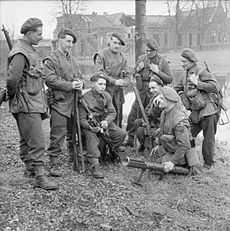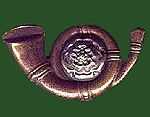King's Own Yorkshire Light Infantry
| The King’s Own Yorkshire Light Infantry (51st and 105th) | |
|---|---|
|
The 'French' Horn and White Rose of the KOYLI | |
| Active | 1881–1968 |
| Country | Great Britain |
| Size | 1–2 Battalions in peacetime, 13 Battalions in World War I, 9 Battalions in World War II |
| Part of | Light Infantry Brigade (1948–68) |
| Garrison/HQ | Pontefract Barracks, Pontefract, West Yorkshire |
| Nickname | 'The Koylis' |
| Patron | George IV (who conferred the 'Royal' title in 1821) |
| Motto | Cede Nullis (Yield to none) |
| Colors | Dark Green, Royal Blue and Off-White |
| March | Quick: "Jockey to the Fair", Double: "The Keel Row", Slow: "Minden March" |
| Anniversaries | Minden Day (1 August) |
| Engagements | The Seven Years' War, The Peninsular War, Waterloo, The Boer War, World War I, World War II |
| Commanders | |
| Ceremonial chief | Queen Elizabeth, The Queen Mother (1924–68) |
| Colonel of the Regiment | Maj-Gen. C J Deedes OBE MC (1966–68) |
| Notable commanders | Sir John Moore (1790–95) |
The King's Own Yorkshire Light Infantry (KOYLI) was a light infantry regiment of the British Army. It officially existed from 1881 to 1968, but its predecessors go back to 1755. In 1968 the regiment was amalgamated with the Somerset and Cornwall Light Infantry, the King's Shropshire Light Infantry and the Durham Light Infantry to form The Light Infantry which in turn became The Rifles in 2007.
Lineage
The 51st Foot
The 53rd Regiment of Foot was raised in Leeds in 1755 and renumbered the 51st in January 1757. In 1782, in common with other regiments of the line, the 51st was given a "county" designation, becoming the 51st (2nd Yorkshire, West Riding) Regiment of Foot. The title of Light Infantry was given in honour of its former commander General Sir John Moore in 1809, and in 1821 the regiment was given royal status when King's Own was added to its title, becoming the 51st (2nd Yorkshire, West Riding, The King's Own Light Infantry) Regiment.[1]
The 105th Foot
The 2nd Madras European Light Infantry was raised by the British East India Company in 1839. In 1861 East India Company forces were absorbed into the British Army, and the regiment became the 105th (Madras Light Infantry) Regiment.[1] In 1878, the 105th was moved to Pontefract, where the KOLI already also had their depot.
The King's Own Yorkshire Light Infantry
In 1881 after the Cardwell and Childers reforms, regimental numbers were abolished. The 51st King's Own Light Infantry became the 1st Battalion, The King's Own Light Infantry (South Yorkshire Regiment) and the 105th became its 2nd Battalion. The Childers reforms also combined militia and rifle volunteer units into the regiments formed in 1881. Accordingly the 1st West Yorks Rifles Miltia became the 3rd Militia Battalion, while the 3rd Administrative Battalion West Riding of Yorkshire Rifle Volunteer Corps became the 1st Volunteer Battalion. In 1897 the regimental title was changed to The King's Own (Yorkshire Light Infantry), and in 1921 to The King's Own Yorkshire Light Infantry.[2]
With the creation of the Territorial Force in 1908, the 1st Volunteer Battalion was reorganised as the 4th and 5th Battalions (TF), while the 3rd Battalion was transferred to the Special Reserve. The KOYLI was raised to thirteen battalions during World War I, and nine during World War II, including not only infantry but anti-aircraft and armoured units as well. During World War II the battalions served in all three fronts (Europe, North Africa and Asia-Pacific).[3] In 1948, 1 KOYLI was disbanded and 2 KOYLI was renamed 1 KOYLI. In 1968, 1 KOYLI became the 2nd Battalion of The Light Infantry (2LI). In 2007 the LI merged with the Devonshire and Dorset Regiment, the Royal Gloucestershire, Berkshire and Wiltshire Regiment, and the Royal Green Jackets to form a new Large regiment, The Rifles. The former 1 KOYLI battalion (now 1LI) became '5 RIFLES'.
History

The 51st first saw action during the Seven Years' War, gaining a reputation at Minden, its first battle honour. In 1803 it served in the first Kandyan War in Major-General Hay Macdowall's division. The regiment embarked for the Peninsula in 1807, serving with distinction. The regiment served on the extreme right at Waterloo, and was engaged at Hougoumont Farm. Both the 51st and 105th saw extensive service all over the Empire throughout the nineteenth century. The Second battalion (105th) fought well in the South African War.
World War I
Both regular battalions served on the Western Front in World War I, as well as three Territorial Force and eight volunteer service battalions of the New Army raised by Lord Kitchener.
World War II
In World War II the regiment's nine battalions represented the new age of warfare. 5th and 8th KOYLI were converted into anti-aircraft units. The 7th KOYLI were armoured (in 1941, becoming 149th Regiment in the Royal Armoured Corps, but continuing to wear their KOYLI cap badge on the black beret of the RAC),.[4]
The 5th Battalion was transferred to the Royal Artillery before the war and converted into the 53rd Light Anti-Aircraft Regiment, Royal Artillery.
The 8th Battalion was raised in 1940 and was also transferred to the Royal Artillery and became the 94th Light Anti-Aircraft Regiment, Royal Artillery.
The 1st Battalion was serving with the 15th Infantry Brigade and was sent to France in 1939.
The 9th Battalion (formerly the Queen's Own Yorkshire Dragoons) was motorized infantry assigned to the 18th Infantry Brigade and attached to the 1st Armoured Division.
The 2/4th Battalion was raised in 1939 in the Territorial Army when the 4th Battalion was split in two, creating the 1/4th Battalion and the 2/4th Battalion. The 2/4th fought with the 46th (West Riding) Infantry Division in the Battle of Dunkirk with the rest of the BEF. They also fought in the Italian Campaign (hence their ironic Regimental Anthem "The D-Day Dodgers").
The 2nd Battalion also fought as a rearguard in the retreat through Burma in 1942.
The 1/4th Battalion of the regiment served throughout the entire North West Europe Campaign crossing the English Channel several days after D-Day as part of the 146th Infantry Brigade, 49th (West Riding) Infantry Division.
After World War II
Reduced to one battalion after the war, the KOYLI took part in peace-keeping and counter-insurgency operations in the Far East. The battalion finally moved to Berlin in 1967, where it joined The Light Infantry.
Kings Own Yorkshire Light Infantry Museum
The Kings Own Yorkshire Light Infantry Museum is housed in the same building as the Doncaster Museum & Art Gallery (53°31′14″N 1°07′38″W / 53.5206°N 1.1273°W). Exhibits include uniforms, weapons, badges, medals, photos and a model of the Pontefract Barracks. Admission is free.
Cap badge
The badge of the KOYLI is unique amongst English light infantry regiments as the horn is of the 'French' type (with a twist). The origins of this are obscure. It appears to have been adopted after Waterloo, however before this the 105th had an 'English' style Bugle horn with a loop. In its centre is the White Rose of York, linking to the regiment's home in Yorkshire. Unusual amongst British Army regiments, the badge lacks a crown. It was also the smallest cap badge used in the British Army.
Famous members
- Ensign (later General Sir) John Moore: Commissioned into the 51st in 1777, Moore went on to command the battalion in 1790. A forward thinking tactician, he was the father of the British light infantry, and is a significant figure to all light infantry and rifle regiments.
- Ensign Joseph Dyas: Dyas twice volunteered to take part in the storming party of the San Christobal fort at Badajoz in 1811. For this brave action he is still toasted by the officers of the KOYLI and LI.
- Captain Basil Liddell Hart: Originally commissioned into the KOYLI and serving in World War I, Liddell Hart went on to become a military writer. He is most noted for his highly influential work on the theory of armoured warfare in the inter-war period.
- Corporal Ernest Hayes: Hayes joined the KOYLI in 1916 and was awarded three Military Medals in 1918 for acts of bravery at the Western Front in France.
- Stuart Cloete: Cloete was commissioned into the KOYLI in 1914. He served in the regiment during the Battle of the Somme before transferring to the Coldstream Guards. After the war Cloete became a famous and prolific writer, publishing fourteen novels, eight non-fictional books and eight volumes of short stories.
The following members of the regiment were awarded the Victoria Cross:
- Pte C. Ward, South Africa 1900
- Maj C.A.L. Yate, France 1914
- L/Cpl F.W. Holmes, France 1914
- Pte H. Waller, France 1917
- Sgt J.W. Ormsby, France 1917
- Pte W. Edwards, Belgium 1917
- Lt Col O.C.S. Watson, France 1918
- Sgt L. Calvert, France 1918
- Lt Col H. Greenwood, France 1918
Captain Percy Bentley was one of four soldiers to be awarded the Military Cross four times, all in the First World War.
The following members of the regiment were awarded the Distinguished Conduct Medal:
- Sgt Henry M. Bond, World War I – Le Catelet, Gouy, Villers Farm & as C.S.M. Le Cateau France, Oct 1918
- Cpl Charles Langfield, World War I – Western Front
The following members of the regiment were awarded the Military Medal:
- Ernest Hayes, Military Medal and two bars, World War I – Western front
- 2nd Lt H.W. Gudgin, World War I – Western front
- L/Cpl Philip Toplis, World War I – Western front
- Edward Francis Scollay, World War I – Western front
- Walter Hidon, World War I – Western front
- L/Cpl Edwin Arthur Wilson, World War II – Anzio
Battle honours
- From 51st Regiment of Foot: Minden, Corunna, Fuentes d'Onor, Salamanca, Vittoria, Pyrenees, Nivelle, Orthes, Peninsula, Waterloo, Pegu, Ali Masjid, Afghanistan 1878–80
- Burma 1885–87, Modder River, South Africa 1899–1902
- The Great War (26 battalions): Mons, Le Cateau, Retreat from Mons, Marne 1914 '18, Aisne 1914 '18, La Bassée 1914, Messines 1914 '17 '18, Ypres 1914 '15 '17 '18, Hill 60, Gravenstafel, St. Julien, Frezenberg, Bellewaarde, Hooge 1915, Loos, Somme 1916 '18, Albert 1916 '18, Bazentin, Delville Wood, Pozières, Guillemont, Flers-Courcelette, Morval, Le Transloy, Ancre 1916, Arras 1917 '18, Scarpe 1917, Langemarck 1917, Menin Road, Polygon Wood, Broodseinde, Poelcappelle, Passchendaele, Cambrai 1917 '18, St. Quentin, Bapaume 1918, Lys, Hazebrouck, Bailleul, Kemmel, Scherpenberg, Tardenois, Amiens, Hindenburg Line, Havrincourt, Épéhy, Canal du Nord, St. Quentin Canal, Beaurevoir, Selle, Valenciennes, Sambre, France and Flanders 1914–18, Piave, Vittorio Veneto, Italy 1917–18, Struma, Macedonia 1915–17, Egypt 1915–16
- The Second World War: Kvam, Norway 1940, Fontenay le Pesnil, Le Havre, Antwerp-Turnhout Canal, Lower Maas, North-West Europe 1944–45, Mine de Sedjenane, Argoub Sellah, North Africa 1943, Sicily 1943, Salerno, Salerno Hills, Cava de Tirreni, Volturno Crossing, Garigliano Crossing, Minturno, Monte Tuga, Anzio, Gemmano Ridge, Carpineta, Defence of Lamone Bridgehead, Italy 1943–45, Sittang 1942, Burma 1942
References
External links
| Wikimedia Commons has media related to King's Own Yorkshire Light Infantry. |
- KOYLI on Lightinfantry.org.uk
- List of the KOYLI Bns in WWI on 1914–1918.net
- Kings Own Yorkshire Light Infantry Museum
- 51st(2nd Yorkshire, West Riding) Light Infantry Napoleonic Re-enactment Group
